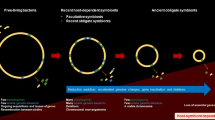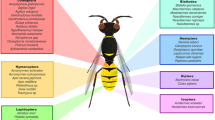Abstract
Insects are amongst the most successful of animals, both in terms of diversity and in colonizing all ecological niches. Recent studies have highlighted the benefi ciary roles that bacteria play in the success and establishment of insects. By adopting techniques like 16S rRNA sequencing we are now in a position to understand the diversity of bacteria present in insect guts. It has been shown that some of these bacteria, like Wolbachia and Cardinium are involved in manipulating insect populations and distorting their sex ratio. Attempts have been made to culture these bacteria in insect cell lines, as they are recalcitrant to culture under normal microbiological conditions. The diversity of bacteria associated with insects and the functional role played by them in the insect is discussed below.
Similar content being viewed by others
References
Sonnenburg JL, Angenent LT and Gordon JI (2004) Getting a grip on things: how do communities of bacterial symbionts become established in our intestine. Nat Immunology 5:569–573
Micchelli CA and Perrimon N (2006) Evidence that stem cells reside in the adult Drosophila midgut epithelium. Nature 439:475–479
Illa-Bochaca I and Montuenga LM (2006) The regenerative nidi of the locust midgut as a model to study epithelial cell differentiation from stem cells. J Experiment Biol 209:2215–2223
Adams MD et al. (2000) The genome sequence of Drosophila melanogaster. Science 287:2185–2195
Lederberg L (2000) Infectious History. Science 288:287–293
Berenbaum MR and Eisner T (2008) Bugs’ bugs. Science 322:52–53
Buchner P (1965) Endosymbiosis of animals with plant microorganisms. New York: Wiley. p 909
Dasch GA, Weiss E and Chaang KP (1984) Endosymbionts of insects. In Bergey’s manual of systematic bacteriology, ed. NR Krieg, JG Holt, pp 811–813. Baltimore: Williamns and Wilkins
Riesenfeld CS, Schloss PD and Handelsman J (2004) Metagenomics: Genomic analysis of microbial communities. Ann Rev Gen 38:525–552
Ward DM, Weller R and Bateson MM (1990) 16S rRNA reveal numerous uncultured microorganisms in a natural community. Nature 345:63–65
O’Neill SL, Giordano R, Colbert AME, Karr TL and Robertson HM (1992) 16S rRNA phylogenetic analysis of the bacterial endosymbiontsassociated with cytoplasmic instability in insects. Proc Natl Acad Sci USA 89:2699–2702
Clark MA, Baumann L, Munson MA, Baumann P, Campbell BC, Duffins JE., Osborne LS and Moran NA (1992) The eubacterial endosymbionts of whitefl ies (Homoptera: Aleyrodidae) constitute a major lineage distinct from the endosymbionts of aphids and mealybugs. Curr Microbiol 5:119–123
Thimm T, Hoffmann A, Borkott H, Munch JC and Tebbe CC (1998) The gut of the soil microarthropod Folsomia candida (Collembola) is a frequently changeable but selective habitat and a vector for microorganisms. Appl Environ Microbiol 64:2660–2669
Hoffmann A, Thimm T, Droge M, Moore ERB, Munch JC and Tebbe CC (1998) Intergeneric transfer of conjugative and mobilizable plasmids harbored by Escherichia coli in the gut of the soil microarthropod Folsomia candida (Collembola). Appl Environ Microbiol 64:2652–2659
Paster BJ, Dewhirst FE, Cooke SM, Fussing V, Poulsen LK and Breznak JA (1996) Phylogeny of not yet-cultured spirochetes from termite guts. Appl Environ Microbiol 62:347–352
Egert M, Stingl U, Bruun LD, Pommerenke B, Brune A and Friedrich MW (2005) Structure and topology of microbial communities in the major gut compartments of Melolontha melolontha larvae (Coleoptera: Scarabaeidae). Appl Environ Microbiol 71:4556–4566
Lemke T, Stingl U, Egert M, Friedrich MW and Brune A (2003) Physicochemical conditions and microbial activities in the highly alkaline gut of the humus-feeding larva of Pachnoda ephippiata (Coleoptera: Scarabaeidae). Appl Environ Microbiol 69:6650–6658
Corby-Harris V, Pontaroli AC, Shimkets LJ, Bennetzen JL, Habel KE and Promislow DEL (2007) Geographical distribution and diversity of bacteria associated with natural populations of Drosophila melanogaster. Appl Environ Microbiol 73:3470–3479
Behar A, Jurkevitch E and Yuval B (2008) Bringing back the fruit into fruit fly-bacteria interactions. Mol Ecology 17:1375–1386
Broderick NA, Raffa KF, Goodman RM and Handelsman J (2004) Census of the bacterial community of the gypsy moth larval midgut by using culturing and culture independent methods. Appl Env Microbiol 70:293–300
James C. (2006) Global Status of Commercialized Biotech/GM Crops: 2006, Int. Serv. Acquis. Agro-Biotech Appl. Briefs No. 35, ISAAA, Ithaca, New York, USA
Broderick NA, Raffa KF and Handelsman J (2006) Midgut bacteria required for Bacillus thuringiensis. Proc Natl Acad Sci USA 103:15196–15199
Santo Domingo JW, Kaufman MG, Klug MJ, Holben WE, Harris D and Tiedje JM (1998) Influence of diet on the structure and function of the bacterial hindgut community of crickets. Mol Ecol 7:761–767
Gijzen HJ, Vanderdrift C, Barugahare M and Opdencamp HJM (1994) Effect of host diet and hindgut microbial composition on cellulolytic activity in the hindgut of the American cockroach, Periplaneta americana. Appl Environ Microbiol 60:1822–1826
Tayasu I, Sugimoto A, Wada E and Abe T (1994) Xylophagous termites depending on atmospheric nitrogen. Naturwissenschaften 81:229–231
Douglas AE (2006) Phloem-sap feeding by animals: problems and solutions. J Exp Botany 57:747–754
Tamas I, Klasson L, Canback B, Naslund AK, Eriksson, AS, Wernegreen JJ, Sandstrom JP, Moran NA, and Andersson SG (2002) 50 million years of genomic stasis in endosymbiotic bacteria. Science 296:2376–2379
Dale C and Moran NA (2006) Molecular interactions between bacterial symbionts and their hosts. Cell 126:453–465
Akman L, Yamashita A, Watanabe H, Oshima K, Shiba T, Hattori M and Aksoy S (2002) Genome sequence of the endocellular obligate symbiont of tsetse flies, Wigglesworthia glossinidia. Nat Genet 32:402–407
Dillon RJ and Charnley AK (1995) Chemical barriers to gut infection in the desert locust-in vivo production of antimicrobial phenols associated with the bacterium Pantoea agglomerans. J Invertebr Pathol 66:72–75
Dillon RJ and Charnley AK (2002) Mutualism between the desert locust Schistocerca gregaria and its gut microbiota. Res Microbiol 153:503–509
Kodama R and Nakasuji Y (1971) Further studies on the pathogenic mechanism of bacterial diseases in gnotobiotic silkworm larvae. IFO Res Comm 5:1–9
Pinheiro VB and Ellar DJ (2006) How to kill a mocking bug? Cell Microbiol 8:545–557
Ha EM, Oh CT, Bae YS and Lee WJ (2005) A direct role for dual oxidase in Drosophila gut immunity. Science 310:848
Ryu JH, Kim SH, Lee HY, Bai JY, Nam YD, Bae JW, Lee DG, Shin SC, Ha EM and Lee WJ (2008) Innate immune homeostasis by the homeobox gene caudal and commensalgut mutualism in Drosophila. Science 319:777–782
Oliver KM, Moran NA and Hunter MS (2005) Variation in resistance to parasitism in aphids is due to symbionts not host genotype. Proc Nat Acad Sci 102:12795–12800
Russel JA and Moran NA (2006) Costs and benefits of symbionts association in aphids: variation among symbionts and across temperatures. Proc R Soc B 273:603–610
Baumann P, Baumann L, and Clark MA (1996) Levels of Buchnera aphidicola chaperonin GroEL during growth of the aphid Schizaphis graminum. Curr Microbiol 32:279–285
Fares MA, Ruiz-Gonzalez MX, Moya A, Elena SF and Barrio E (2002) Endosymbiotic bacteria: GroEL buffers against deleterious mutations. Nature 417:398
Power AG (2000) Insect transmission of plant viruses: a constraint on virus variability. Current Opinion in Plant Biology 3:336–340
Morin S, Ghanim M, Zeidan M, Czosnek H, Verbeek M and van den Heuvel JF (1999) A GroEL homologue from endosymbiotic bacteria of the whitefly Bemisia tabaci is implicated in the circulative transmission of tomato yellow leaf curl virus. Virology 256:75–84
Hogenhout SA, van der WF, Verbeek M, Goldbach RW and van den Heuvel JF (2000) Identifying the determinants in the equatorial domain of Buchnera GroEL implicated in binding potato leafroll virus. J Virol 74:4541–4548
McGraw EA and O’Neill SL (2004) Wolbachia pipientis: intracellular infection and pathogenesis in Drosophila. Curr Opin Microbiol 7:7–70
Hoerauf A and Rao RU (2007) Wolbachia: a bugs life in another bug. Issues in Infectious Diseases. Vol. 5. Karger, Basel.
Zchori-Fein E and Perlman SJ (2004) Distribution of the bacterial symbiont Cardinium in arthropods. Mol Ecology 13: 2009–2016
Perlman SJ, Kelly SE and Hunter MS (2008) Population biology of cytoplasmic incompatibility: maintenance and spread of Cardinium symbionts in a parasitic wasp. Genetics 178:1003–1011
Panagiotis I and Bourtzis K (2007) Insect symbionts and applications: The paradigm of cytoplasmic incompatibility-inducing Wolbachia. Entomol Res 37:125–138
Author information
Authors and Affiliations
Corresponding author
Rights and permissions
About this article
Cite this article
Rajagopal, R. Beneficial interactions between insects and gut bacteria. Indian J Microbiol 49, 114–119 (2009). https://doi.org/10.1007/s12088-009-0023-z
Received:
Accepted:
Published:
Issue Date:
DOI: https://doi.org/10.1007/s12088-009-0023-z




